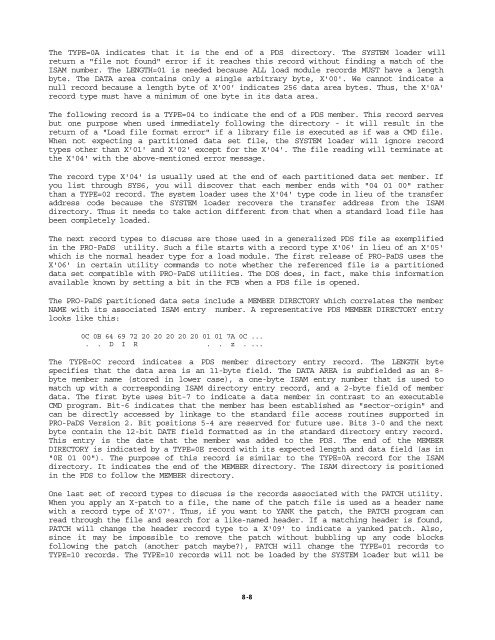The Programmer's Guide to TRSDOS Version 6 - Tim Mann's Home ...
The Programmer's Guide to TRSDOS Version 6 - Tim Mann's Home ...
The Programmer's Guide to TRSDOS Version 6 - Tim Mann's Home ...
Create successful ePaper yourself
Turn your PDF publications into a flip-book with our unique Google optimized e-Paper software.
<strong>The</strong> TYPE=0A indicates that it is the end of a PDS direc<strong>to</strong>ry. <strong>The</strong> SYSTEM loader will<br />
return a "file not found" error if it reaches this record without finding a match of the<br />
ISAM number. <strong>The</strong> LENGTH=01 is needed because ALL load module records MUST have a length<br />
byte. <strong>The</strong> DATA area contains only a single arbitrary byte, X'00'. We cannot indicate a<br />
null record because a length byte of X'00' indicates 256 data area bytes. Thus, the X'0A'<br />
record type must have a minimum of one byte in its data area.<br />
<strong>The</strong> following record is a TYPE=04 <strong>to</strong> indicate the end of a PDS member. This record serves<br />
but one purpose when used immediately following the direc<strong>to</strong>ry - it will result in the<br />
return of a "Load file format error" if a library file is executed as if was a CMD file.<br />
When not expecting a partitioned data set file, the SYSTEM loader will ignore record<br />
types other than X'01' and X'02' except for the X'04'. <strong>The</strong> file reading will terminate at<br />
the X'04' with the above-mentioned error message.<br />
<strong>The</strong> record type X'04' is usually used at the end of each partitioned data set member. If<br />
you list through SYS6, you will discover that each member ends with "04 01 00" rather<br />
than a TYPE=02 record. <strong>The</strong> system loader uses the X'04' type code in lieu of the transfer<br />
address code because the SYSTEM loader recovers the transfer address from the ISAM<br />
direc<strong>to</strong>ry. Thus it needs <strong>to</strong> take action different from that when a standard load file has<br />
been completely loaded.<br />
<strong>The</strong> next record types <strong>to</strong> discuss are those used in a generalized PDS file as exemplified<br />
in the PRO-PaDS utility. Such a file starts with a record type X'06' in lieu of an X'05'<br />
which is the normal header type for a load module. <strong>The</strong> first release of PRO-PaDS uses the<br />
X'06' in certain utility commands <strong>to</strong> note whether the referenced file is a partitioned<br />
data set compatible with PRO-PaDS utilities. <strong>The</strong> DOS does, in fact, make this information<br />
available known by setting a bit in the FCB when a PDS file is opened.<br />
<strong>The</strong> PRO-PaDS partitioned data sets include a MEMBER DIRECTORY which correlates the member<br />
NAME with its associated ISAM entry number. A representative PDS MEMBER DIRECTORY entry<br />
looks like this:<br />
0C 0B 64 69 72 20 20 20 20 20 01 01 7A 0C ...<br />
. . D I R . . z . ...<br />
<strong>The</strong> TYPE=0C record indicates a PDS member direc<strong>to</strong>ry entry record. <strong>The</strong> LENGTH byte<br />
specifies that the data area is an 11-byte field. <strong>The</strong> DATA AREA is subfielded as an 8byte<br />
member name (s<strong>to</strong>red in lower case), a one-byte ISAM entry number that is used <strong>to</strong><br />
match up with a corresponding ISAM direc<strong>to</strong>ry entry record, and a 2-byte field of member<br />
data. <strong>The</strong> first byte uses bit-7 <strong>to</strong> indicate a data member in contrast <strong>to</strong> an executable<br />
CMD program. Bit-6 indicates that the member has been established as "sec<strong>to</strong>r-origin" and<br />
can be directly accessed by linkage <strong>to</strong> the standard file access routines supported in<br />
PRO-PaDS <strong>Version</strong> 2. Bit positions 5-4 are reserved for future use. Bits 3-0 and the next<br />
byte contain the 12-bit DATE field formatted as in the standard direc<strong>to</strong>ry entry record.<br />
This entry is the date that the member was added <strong>to</strong> the PDS. <strong>The</strong> end of the MEMBER<br />
DIRECTORY is indicated by a TYPE=0E record with its expected length and data field (as in<br />
"0E 01 00"). <strong>The</strong> purpose of this record is similar <strong>to</strong> the TYPE=0A record for the ISAM<br />
direc<strong>to</strong>ry. It indicates the end of the MEMBER direc<strong>to</strong>ry. <strong>The</strong> ISAM direc<strong>to</strong>ry is positioned<br />
in the PDS <strong>to</strong> follow the MEMBER direc<strong>to</strong>ry.<br />
One last set of record types <strong>to</strong> discuss is the records associated with the PATCH utility.<br />
When you apply an X-patch <strong>to</strong> a file, the name of the patch file is used as a header name<br />
with a record type of X'07'. Thus, if you want <strong>to</strong> YANK the patch, the PATCH program can<br />
read through the file and search for a like-named header. If a matching header is found,<br />
PATCH will change the header record type <strong>to</strong> a X'09' <strong>to</strong> indicate a yanked patch. Also,<br />
since it may be impossible <strong>to</strong> remove the patch without bubbling up any code blocks<br />
following the patch (another patch maybe?), PATCH will change the TYPE=01 records <strong>to</strong><br />
TYPE=10 records. <strong>The</strong> TYPE=10 records will not be loaded by the SYSTEM loader but will be<br />
8-8















